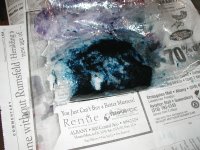Butternuts=golden brown







Lots of dye books and websites tell you the colors you can expect from onions, and some suggest different mordants, but when it came right down to it, almost none of them tell you the step-by-step directions on HOW to do it. Sure, it's simple if you KNOW how to do it....but how about directions for the rest of us?
First, I was worried about colorfastness. What I read suggested onion was, by itself, pretty decent, but I wanted insurance. So I pre-soaked the merino superwash in alum water. (I had previously dissolved alum in water for use an another dye project, and they suggested saving the water with its trace amounts of alum to start the recipe the next time.) So I wetted the yarn in the weak alum solution, and was relieved to see almost no residue or color to the yarn. I was worried, as the alum water had darkened over time...
So then I used the same alum water, about 4 cups, in the dye pot. I added an additional 4 cups of tap water (and we have some iron in our water) and three large handfuls of collected skins from yellow onions.

I brought this to a boil, and then turned down the heat and let it simmer for about 45 minutes. Then I removed the bulk of the onion skins with a spoon, and put it the yarn.

Just from the way it is sitting in the dye pot, you can tell there will be variations in the intensity of color, and that's fine with me. I let it sit for about 20 minutes, and then took it out and gently squeezed the excess dye liquid out...

Even here you can see the variation in intensity of dye. I'm sure if I had stirred it around, I could have achieved a thorough coloring of the intense yellow seen to the left.
This gorgeous hank dried overnight and was wound on the noddy, and secreted away to the stash, to be used on (what else?) socks. Saved for one of the more intricate patterning socks, where our usual variegated colors would hide the pattern work from all but the really curious. And frankly, I don't want people that close to my feet...


 alarming; blotting took up a ton more than we do when we use the wool yarn, and even upon rolling up the fleece to steam set, you can see the dye settling to the bottom. Good thing I used plastic both above and below the fleece so the rolled fleece could not touch back on itself and spread dye through contact.
alarming; blotting took up a ton more than we do when we use the wool yarn, and even upon rolling up the fleece to steam set, you can see the dye settling to the bottom. Good thing I used plastic both above and below the fleece so the rolled fleece could not touch back on itself and spread dye through contact.